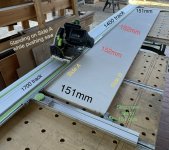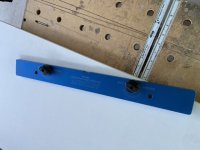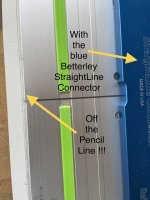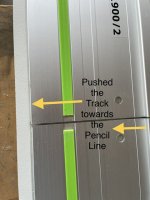Preparing panels for use by cutting a parallel edge (Side A) to the straight line ripped edge (Side B).
I set the Festool Parallel Edge Guide to 151mm. (Calibrated to 300mm a few minutes prior).
I did the parallel cut operation twice. Each time there was an extra 1mm of board in the middle of the panel.
At the ends of the panel the desired 151mm was there. But not in the middle of the panel, it was 152mm.
Using the Betterley Straightline Connector, I joined the 1400 and 1700 tracks.
A buddy said I was walking on the wrong side of the tracks. In other words, I did not have to dodge the Parallel Edge Guides by swiveling my hips or angling my arms backwards.
Another buddy said my rails were not joined perfectly, or the joined tracks have deviation in the middle.
I’m gonna get a foam board to lay down on the Kreg ACS table to avoid cutting into their metal tracks. Then I will walk on Side B.
What y’all think?
I set the Festool Parallel Edge Guide to 151mm. (Calibrated to 300mm a few minutes prior).
I did the parallel cut operation twice. Each time there was an extra 1mm of board in the middle of the panel.
At the ends of the panel the desired 151mm was there. But not in the middle of the panel, it was 152mm.
Using the Betterley Straightline Connector, I joined the 1400 and 1700 tracks.
A buddy said I was walking on the wrong side of the tracks. In other words, I did not have to dodge the Parallel Edge Guides by swiveling my hips or angling my arms backwards.
Another buddy said my rails were not joined perfectly, or the joined tracks have deviation in the middle.
I’m gonna get a foam board to lay down on the Kreg ACS table to avoid cutting into their metal tracks. Then I will walk on Side B.
What y’all think?





